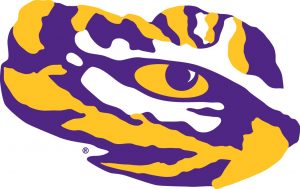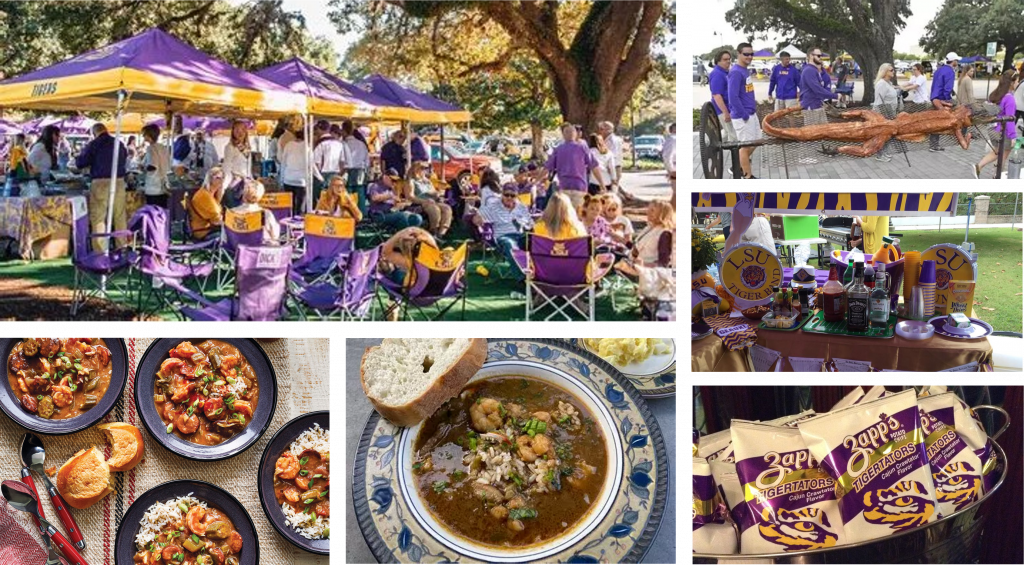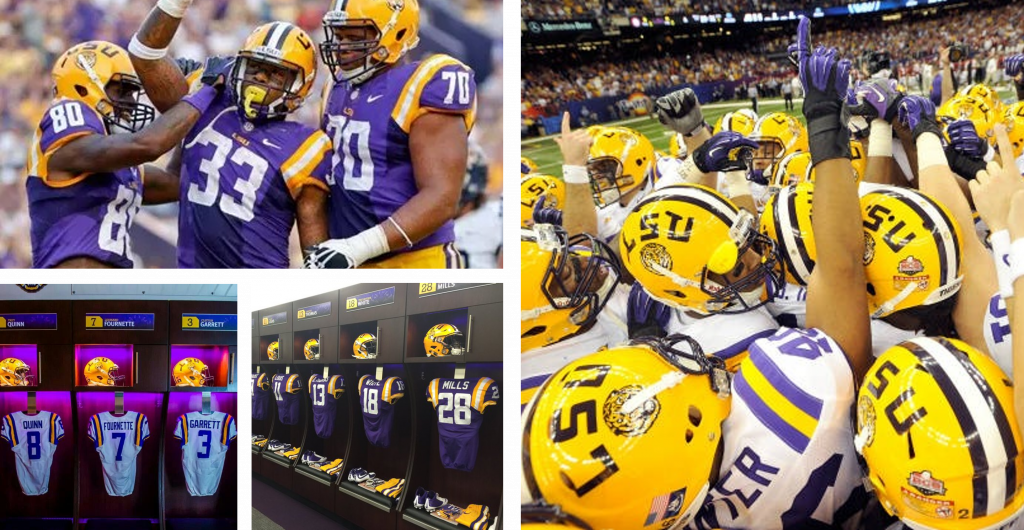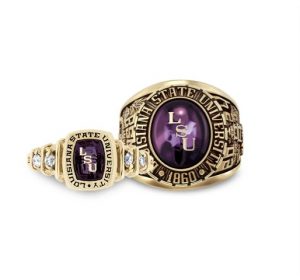
Geaux Tigers!
Louisiana State University
Location: Baton Rouge, LA
Nickname: Fighting Tigers
Type of School: Public Land Grant Research University
Mascot: “Mike the Tiger VIII” (Bengal-Siberian mix)
Total student body: 42,016 (Fall 2024)
University Established: 1860
Football Stadium: Tiger Stadium
Capacity: 102,321
Team Colors: Purple and Gold

Alma Mater
Where stately oaks and broad magnolias shade inspiring halls
There stands our dear old Alma Mater who to us recalls
Fond memories that waken in our hearts a tender glow
And make us happy for the love that we have learned to know
All praise to thee our Alma Mater, molder of mankind
May greater glory, love unending be forever thine
Our worth in life will be thy worth we pray to keep it true
And may thy spirit live in us, forever L-S-U (Geaux Tigers!)
The "Home White" Tradition
Those striking, proud, and awesome “home white” jerseys flash before you on fall Saturday nights in Death Valley.
To the loyal Tiger fan, they are an institution and are as much a part of making LSU football a proud religion. A legit national power most of the time and a serious factor nearly all of the time.
Battling NCAA for right to wear white
It all started in 1958 when Tigers coach Paul Dietzel decided that his team should wear white at home. Many think it had to do with the heat and humidity in south Louisiana, the away teams only had to deal with it for a day, but the “Bayou Bengals” had to live with it 24/7! And when LSU won the national championship that year, well, the white jerseys at home were in Baton Rouge to stay.
In 1983, new NCAA rules prohibited home teams from wearing white, so LSU was forced to wear its purple jerseys at home between 1983 and ’94. Despite winning SEC titles in 1986 and ’88, Tiger fans often complained the purple threads were bad luck and that an important Bayou football tradition had been unfairly taken away.
In 1993, coach Curley Hallman asked the NCAA if LSU could start wearing the white jerseys at home again during LSU football’s 100th season, but he was denied.
It looked like “The Home Whites” tradition would be gone forever, only to be remembered in photos and old videos. But in 1995, new Head Football Coach, Gerry DiNardo, decided he would try and save this fading tradition.
DiNardo did everything he could to restore the lore of the white jerseys. He met with each member of the NCAA Football Rules Committee personally, and his effort and persistence eventually paid off. The NCAA finally approved the request, and LSU was again allowed to wear the white jerseys in Tiger Stadium. They revived the tradition that autumn, and it has been in place since.
As if a sign from above, an unranked LSU team beat No. 6 Auburn 12-6 in the first home game back in the white uniforms, and all was right in the Bayou again.
P.S. The psychology of color suggests darker colors can sometimes make players appear larger and more imposing, potentially creating a feeling of inferiority in the opponent. Conversely, white can create a perception of speed and agility. While the empirical impact of uniform color on athletic performance is subtle at best, it is a factor that LSU, like many programs, has considered in its uniform strategy. LSU’s “Home White” jerseys offer a visual distinctiveness that can play a role in the psychological warfare of a football game.
Tailgating is an adventure at LSU
- Cajun cooking: Food is always at the heart of an LSU tailgate. Many fans cook elaborate, homemade Cajun and Creole delicacies in large “cast iron” pots or use smokers, fryers, and anything else they think will help.
- Signature dishes: Common dishes one might find at an LSU tailgate are jambalaya, gumbo, boudin, and fried seafood. For games against rival Florida, fans might even smoke or fry a whole alligator.
- A Generous spirit: Tailgating hosts will often share their delicious food with neighboring groups and visiting fans, reinforcing their reputation for good fun and hospitality.

OMG!! YUM!!!

LSU Ring Tradition

From stately oaks and broad magnolias to the thrill of Saturday night in Tiger Stadium, the LSU Ring is a permanent symbol of your LSU experience and connection to past, present, and future LSU students. Long considered a Tiger tradition and academic milestone for juniors, the LSU Ring is reserved for currently enrolled undergraduates who have completed 75 credit hours, currently enrolled graduate students who have completed 18 credit hours, and LSU alumni.
Each LSU ring represents the uniqueness of Louisiana State University and serves as a lasting symbol of LSU’s proud traditions and values. Oak leaves and magnolia blossoms are carved on both sides. One side features the degree received, gates of LSU, and Seal of the University over the last two words of the Alma Mater, “Forever LSU.” The other side shows the year of graduation, Memorial Tower, and eye of Mike the Tiger. LSU is encrusted on top of an amethyst stone. The words “Louisiana State University” and the founding date of 1860 encircle the stone.
Prior to commencement, students wear the ring with “LSU” facing them as a reminder of the goal within reach. Upon granting of degrees at commencement, graduates turn the ring so that “LSU” faces outward. This symbolizes a graduate’s readiness to represent LSU in their post-grad success.
Trivia
- LSU is officially known as the “Fighting Tigers”.
- The “Geaux Tigers” cheer and saying uses a phonetic spelling of “go” in the Cajun French dialect, honoring Louisiana’s French/Cajun heritage.
- LSU has achieved national championships in various sports, including football, baseball, women’s basketball, boxing, men’s golf, gymnastics, men’s indoor track, women’s indoor track, and men’s outdoor track.
- LSU is one of the only universities in the nation to offer a minor in French with an emphasis on Cajun French.
- Mike the Tiger – LSU’s Live Mascot enclosure is visited by over 100,000 fans yearly. He can be observed 24 hours a day at MiketheTiger.com

